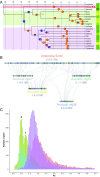The avocado genome informs deep angiosperm phylogeny, highlights introgressive hybridization, and reveals pathogen-influenced gene space adaptation
- PMID: 31387975
- PMCID: PMC6708331
- DOI: 10.1073/pnas.1822129116
The avocado genome informs deep angiosperm phylogeny, highlights introgressive hybridization, and reveals pathogen-influenced gene space adaptation
Abstract
The avocado, Persea americana, is a fruit crop of immense importance to Mexican agriculture with an increasing demand worldwide. Avocado lies in the anciently diverged magnoliid clade of angiosperms, which has a controversial phylogenetic position relative to eudicots and monocots. We sequenced the nuclear genomes of the Mexican avocado race, P. americana var. drymifolia, and the most commercially popular hybrid cultivar, Hass, and anchored the latter to chromosomes using a genetic map. Resequencing of Guatemalan and West Indian varieties revealed that ∼39% of the Hass genome represents Guatemalan source regions introgressed into a Mexican race background. Some introgressed blocks are extremely large, consistent with the recent origin of the cultivar. The avocado lineage experienced 2 lineage-specific polyploidy events during its evolutionary history. Although gene-tree/species-tree phylogenomic results are inconclusive, syntenic ortholog distances to other species place avocado as sister to the enormous monocot and eudicot lineages combined. Duplicate genes descending from polyploidy augmented the transcription factor diversity of avocado, while tandem duplicates enhanced the secondary metabolism of the species. Phenylpropanoid biosynthesis, known to be elicited by Colletotrichum (anthracnose) pathogen infection in avocado, is one enriched function among tandems. Furthermore, transcriptome data show that tandem duplicates are significantly up- and down-regulated in response to anthracnose infection, whereas polyploid duplicates are not, supporting the general view that collections of tandem duplicates contribute evolutionarily recent "tuning knobs" in the genome adaptive landscapes of given species.
Keywords: Phytophthora; angiosperm phylogeny; avocado genome; genome duplications; genome evolution.
Copyright © 2019 the Author(s). Published by PNAS.
Conflict of interest statement
The authors declare no conflict of interest.
Figures



Similar articles
-
Persea americana (avocado): bringing ancient flowers to fruit in the genomics era.Bioessays. 2008 Apr;30(4):386-96. doi: 10.1002/bies.20721. Bioessays. 2008. PMID: 18348249
-
EST sequencing and gene expression profiling of defence-related genes from Persea americana infected with Phytophthora cinnamomi.BMC Plant Biol. 2011 Nov 23;11:167. doi: 10.1186/1471-2229-11-167. BMC Plant Biol. 2011. PMID: 22108245 Free PMC article.
-
Widespread genome duplications throughout the history of flowering plants.Genome Res. 2006 Jun;16(6):738-49. doi: 10.1101/gr.4825606. Epub 2006 May 15. Genome Res. 2006. PMID: 16702410 Free PMC article.
-
Bioactive Molecules From Native Mexican Avocado Fruit (Persea americana var. drymifolia): A Review.Plant Foods Hum Nutr. 2021 Jun;76(2):133-142. doi: 10.1007/s11130-021-00887-7. Epub 2021 Mar 11. Plant Foods Hum Nutr. 2021. PMID: 33704631 Review.
-
Polyploidy and interspecific hybridization: partners for adaptation, speciation and evolution in plants.Ann Bot. 2017 Aug 1;120(2):183-194. doi: 10.1093/aob/mcx079. Ann Bot. 2017. PMID: 28854567 Free PMC article. Review.
Cited by
-
The Phoebe genome sheds light on the evolution of magnoliids.Hortic Res. 2020 Sep 1;7:146. doi: 10.1038/s41438-020-00368-z. eCollection 2020. Hortic Res. 2020. PMID: 32922818 Free PMC article.
-
Research Progress in Plant Molecular Systematics of Lauraceae.Biology (Basel). 2021 May 1;10(5):391. doi: 10.3390/biology10050391. Biology (Basel). 2021. PMID: 34062846 Free PMC article. Review.
-
Advances in Understanding Defense Mechanisms in Persea americana Against Phytophthora cinnamomi.Front Plant Sci. 2021 Mar 1;12:636339. doi: 10.3389/fpls.2021.636339. eCollection 2021. Front Plant Sci. 2021. PMID: 33747014 Free PMC article. Review.
-
The chromosome-scale genome of Magnolia officinalis provides insight into the evolutionary position of magnoliids.iScience. 2021 Aug 17;24(9):102997. doi: 10.1016/j.isci.2021.102997. eCollection 2021 Sep 24. iScience. 2021. PMID: 34505009 Free PMC article.
-
Single-nucleotide polymorphisms that uniquely identify cultivars of avocado (Persea americana).Appl Plant Sci. 2021 Jul 8;9(6):e11440. doi: 10.1002/aps3.11440. eCollection 2021 Jun. Appl Plant Sci. 2021. PMID: 34268019 Free PMC article.
References
-
- Chanderbali A. S., et al. , Persea americana (avocado): Bringing ancient flowers to fruit in the genomics era. BioEssays 30, 386–396 (2008). - PubMed
-
- Christenhusz M. J., Byng J. W., The number of known plants species in the world and its annual increase. Phytotaxa 261, 201–217 (2016).
-
- Statista Research Department, Avocado industry–Statistics & facts. https://www.statista.com/topics/3108/avocadoindustry/. Accessed 29 July 2019.
-
- Fresh Plaza, Mexico: Avocado exports generate 2.5 billion dollars. https://www.freshplaza.com/article/178230/Mexico-Avocado-exportsgenerate.... Accessed 29 July 2019.
-
- Galindo-Tovar M. E., Arzate-Fernández A. M., Ogata-Aguilar N., Landero-Torres I., The avocado (Persea americana, Lauraceae) crop in Mesoamerica: 10,000 years of history. Harv. Pap. Bot. 12, 325–334 (2007).
Publication types
MeSH terms
Substances
Associated data
- Actions
- Actions
- Actions
- Actions

